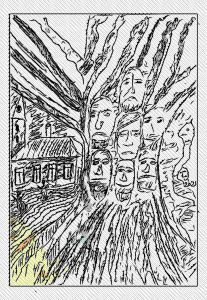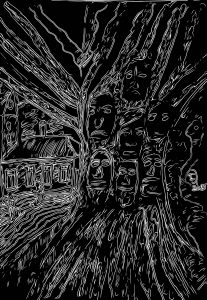

117 Wurzeln der Erinnerung – Die Gesichter im Baum
Künstler: LTJ
Format: A3, Digitaldruck
Versionen:
1. Schwarz-Weiß
2. Grün, 60er Jahre Stil
3. Acryl-Version
Preis auf Anfrage
⸻
Rezension:
Dieses Werk von LTJ wirkt wie ein visuelles Gedicht über Herkunft, Zeit und Vergänglichkeit. Der mächtige Baum im Zentrum der Komposition trägt nicht Blätter oder Früchte, sondern Gesichter – Gesichter, die aus dem Holz zu sprechen scheinen. Sie blicken ernst, nachdenklich, manchmal resigniert. Jeder Ausdruck erzählt eine Geschichte, jedes Auge blickt aus einer anderen Epoche, einem anderen Leben.
Der Stamm verwurzelt sich tief im Bildgrund und strahlt eine Schwere aus, die zugleich Geborgenheit vermittelt. Als wäre dieser Baum ein Speicher für Erinnerungen, ein Archiv der Ahnen. Die Äste reichen weit, wie Synapsen eines kollektiven Gedächtnisses, das nie vergisst.
Links neben dem Baum steht ein kleines Haus mit Satteldach – vielleicht ein Schulhaus, vielleicht ein Wohnort. Menschen in einfacher Kleidung bewegen sich davor, fast wie in einem Standbild vergangener Tage. Der Kontrast zwischen organischem Baum und der Architektur der Erinnerung verstärkt die Tiefe des Bildes.
In der Schwarz-Weiß-Version betonen die Kontraste das Dokumentarische des Motivs – wie ein altes Fotoalbum. Die grüne 60er-Jahre-Version gibt dem Ganzen einen nostalgisch-verträumten Schleier. Die Acryl-Variante könnte mit rötlich-braunen Tönen für den Baum und hellen Gesichtsflächen die emotionale Wärme intensivieren.
Ein Werk, das innehalten lässt – ein Stammbaum im wahrsten Sinne des Wortes, gezeichnet mit Empathie und historischer Tiefe. LTJ zeigt einmal mehr, dass Erinnerung auch eine Landschaft ist.
117 Roots of Memory – The Faces in the Tree
Artist: LTJ
Format: A3, Digital Print
Versions:
1. Black and White
2. Green, 60s Style
3. Acrylic Version
⸻
Review:
This work by LTJ feels like a visual poem about origin, time, and transience. The mighty tree at the center of the composition bears not leaves or fruit, but faces—faces that seem to speak from the wood. They look serious, contemplative, sometimes resigned. Each expression tells a story, each eye gazes from a different era, a different life.
The trunk is deeply rooted in the ground of the image and radiates a weight that also conveys a sense of shelter. As if this tree were a repository of memories, an archive of ancestors. The branches stretch out wide, like the synapses of a collective memory that never forgets.
To the left of the tree stands a small house with a gabled roof—perhaps a schoolhouse, perhaps a place of living. People in simple clothing move in front of it, almost like a still image from days gone by. The contrast between the organic tree and the architecture of memory deepens the emotional resonance of the image.
In the black-and-white version, the contrasts emphasize the documentary quality of the motif—like an old photo album. The green 60s-style version gives it a nostalgic, dreamy veil. The acrylic version might bring warm reddish-brown tones to the tree and light faces, enhancing the emotional warmth.
A work that invites pause—a family tree in the truest sense of the word, drawn with empathy and historical depth. Once again, LTJ shows that memory is also a landscape.
Preis auf Anfrage
_________________________________________________________


